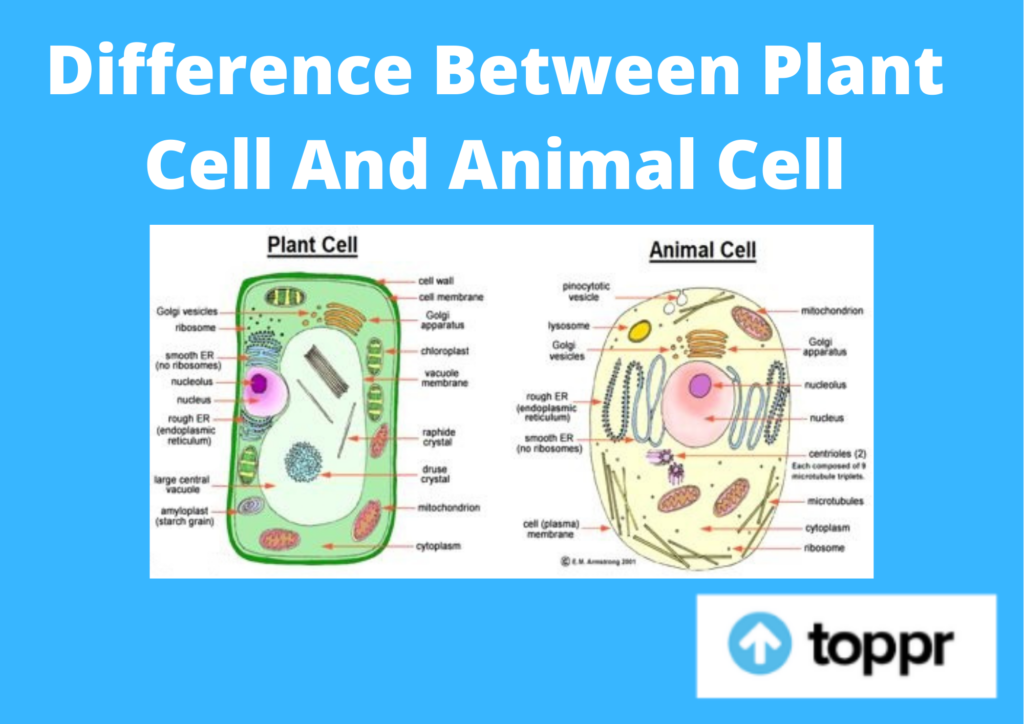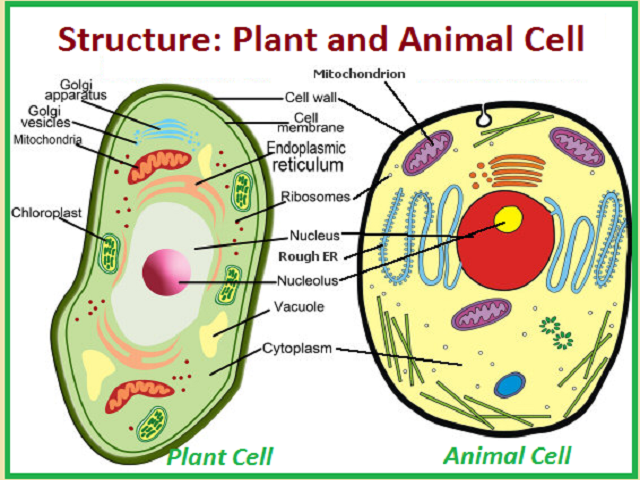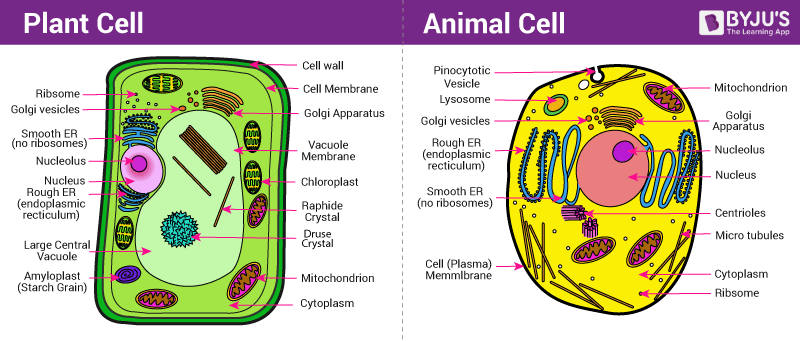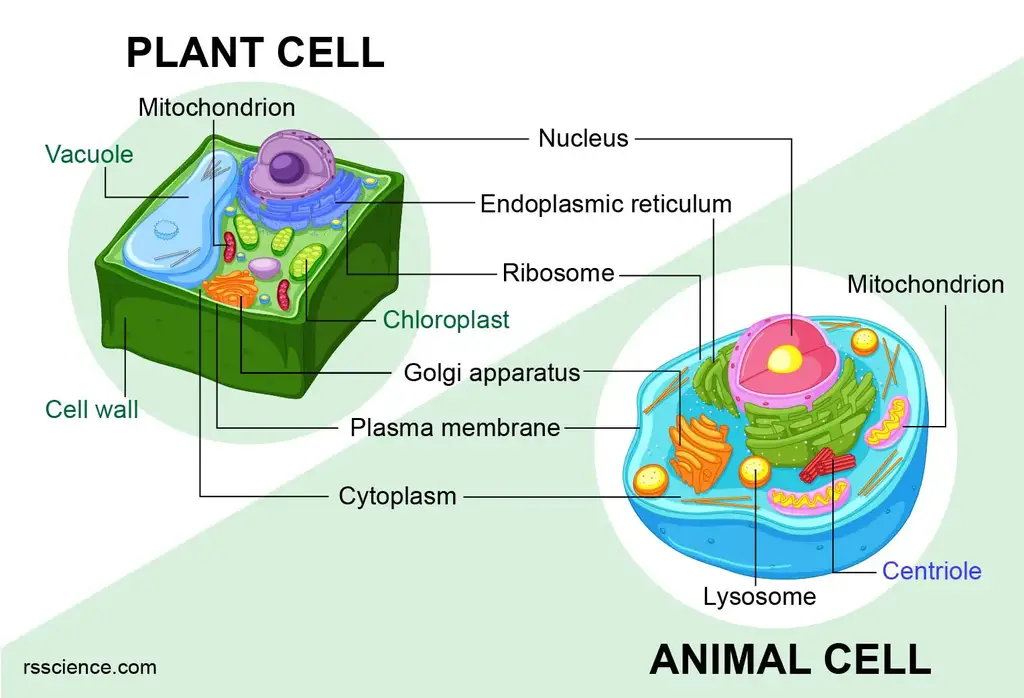Explain Why Plant Cells Are Different Than Animals Cells
This structure is caused by the cell wall which is very rigid and therefore forces the cell to have a defined shape. Unlike animal cell generation patterns cytokinesis is said to be different in plant cells and this is due to the presence of cell walls and cell membranes in the plant cells.

Difference Between Plant Cell And Animal Cell In Tabular Form
They protect the cell from potential harm and act as a vacuum cleaner of the cell.

. A plant cell contains a large singular vacuole that is used for storage of water and nutrients. Plant cells have a big central vacuole that takes up the majority of the volume and expands the cell. It is the chloroplast in plants which is responsible for harvesting light from the sun and performing photosynthesis in.
Both plant and animal cells have vacuoles. Vacuoles are the membrane-bound cell organelles found in all plant and animal cells. Whereas an animal cell only has a cell.
In plants the cell wall. Animal cells range from 10 to 30 micrometers in length while. Most animal cells have at least three main parts.
Plant DNA extraction requires the disruption of the cell wall cell membrane and nuclear membrane while animal DNA extraction requires the breakdown of the cell membrane and nuclear membrane. A plant cell is more rectangular and an animal cell is more of an oval A plant cell has a cell wall cell membrane chloroplasts a cytoplasm and vacuole. Prophase metaphase anaphase and telophase.
It must be established at the time of cell division. Upon swelling with water they become turgid. Both animal mitosis and plant mitosis produce two daughter cells with the same amount of genetic material.
Animal and plant mitosis are two types of reproductive cell divisions which are used to increase the cell number in animals and plants respectively. The main difference between the animal and plant cell is that the animal cell is not able to make their own food. Animal cells come in various sizes and tend to have round or irregular.
Differences Between Animal Cells and Plant Cells Size. The formation of a mid-body during the cytokinesis process is one of the most striking features that differentiate the plant and animal cell cytokinesis. Thanks for asking Answer 2.
This problem has been solved. This is because plant cells have a rigid cell wall around the plasma membrane. In contrast an animal cell has a mid-body of actin and myosin-II microfilaments that form a.
Plant cells have a cell wall as well as a cell membrane. Plant cells have cell walls around them and animal cells dont have cell wallsThe cell walls give plant cells their boxy shapes. So animal cells can have various shapes but plant cells only have the shapes of their cell walls.
Unlike an animal cell the plant cell does not burst. They are the enclosed organs filled with water along with various organic and inorganic molecules. A plant cell possesses a mid-body of phragmoplast remains of mitotic spindles and some vesicles filled with the cellular material.
A major difference between a plant cell and an animal cell is the presence of chloroplast in plants while it is absent in case of animals. The water moves from a region of low osmolarity extracellular fluid to a region of high osmolarity inside the cell. It also helps maintain the shape of the cell.
For instance plant vacuoles tend to be acidic and contain enzymes that act like those in lysosomes in animal cells. The cell would then expand. In contrast animal cells have many smaller vacuoles which also are used for storage of water and nutrients.
Cytokinesis in plant cells is different than cytokinesis in animal cells. All cells have cell membranes and the membranes are flexible. Animal cells are eukaryotic cells that contain a membrane-bound nucleus.
Cytokinesis in a plant cell or division of cytoplasm in a plant cell is different from an animal cell due to the presence of the cell wall. Why are plant cells typically greater in size than animal cells. Plants have a rigid cell wall to provide a specific form to the cell.
Animal cells and plant cells have mitochondria that convert sugars into. The plant has the largest vacuole than animal cells because in plant cells the larger central vacuole. Animal cells are generally smaller than plant cells.
Animal cells have centrioles that support the organization of mitotic spindle and completion of cytokinesis. Plant cells are not necessarily square but they due tend to have distinct edges and be somewhat rectangular. They are different.
Both processes occur through four stages. There are trillions of cells in the animal body and each one is different depending on the function and type. Plant cells dont have centrioles.
Plant cells have chloroplasts which utilize chlorophyll in order to convert sunlight and CO2 into sugars photosynthesis. A Explain why it has to be different and b briefly describe the processes in the two different cell types. In most animal cells this vacuole is either found to be small in size or are absent.
Nucleus cell membrane and cytoplasm. On the other hand Cytokinesis begins in prophase in plant cells which is formed through vesicles in the centre of a cell that causes the formation of the Cell wall and ultimately engenders the division. The major difference between an animal cell and a plant cell is that plants are made up of an extra-rigid cell wall and therefore a special kind of microtubules are involved in.
More importantly animal cell DNA extraction does not require the disruption of cell walls by grinding in dry ice or liquid nitrogen. Because of the size of the vacuoles in plant cells often occupying most of the space in each cell they are used for many of the functions for which animal cells use other organelles.

Difference Between Plant And Animal Cell Are Explained In Detail

What Is The Structure Of Plant And Animal Cells

Animal Vs Plant Cells Similarities Differences Chart And Examples Rs Science
No comments for "Explain Why Plant Cells Are Different Than Animals Cells"
Post a Comment